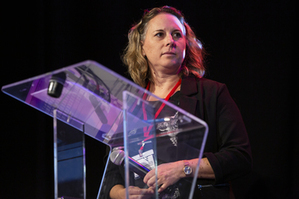Robotization of antineoplastic drugs preparation: towards a risk reduction for staff of Pharmacotechny Unit.
3 October 2019
Canal-Raffin M1,2,3, Léger C2, Atgé B4, Mouilleron C1,3, Larrieu C1,3, Da Silva Caçao O1, Molimard M1, Villa A5, Crauste Manciet S6,7, Verdun-Esquer C3,41 Laboratoire de Pharmacologie Clinique et de Toxicologie, CHU de Bordeaux, France
2 Service de Santé Travail Environnement, CHU de Bordeaux, France
3 INSERM U1219, équipe EPICENE, Université de Bordeaux, France
4 AHI33, Service de Santé au Travail, Bordeaux, France
5 Consultation de Pathologie Professionnelle, Hôpital la Timone (AP-HM), Marseille, France
6 U1212 Inserm-UMR 5320 CNRS, ARNA Laboratoire ChemBioPharm, Université de Bordeaux, France
7 Département de Pharmacotechnie, CHU Bordeaux, France

Context – objective
Antineoplastic drugs preparation number is increasing each day. Robotization generalization for standardized preparations in terms of doses would have the advantage of improving the productivity and the quality but also reducing health risks for staff of Pharmacotechny Unit. Our occupational health department was therefore asked to study associated risks using a robot (PSM II Kiro®) for antineoplastic drugs (AD) preparation.
Method
A multidisciplinary team conducted a process observation along the lifecycle of AD and workplace AD contamination study during two days of injectable 5-Fluoro-uracile (5FU) and cyclophosphamide (CP) preparations.
Bordeaux CHU’s kits allowed occupational health department to perform surface sampling on chemotherapies bags prepared by the robot or by technicians with isolator, on overpacks and inside the robot end day before and after automatic cleaning. Samples were analysed with high sensitive UHPLC-MS/MS method (Limits of quantification: LOQ5-FU =1pg/cm2; LOQCP = 0.05pg/cm2).
Results
Studies highlight physics risks diminution with the robot like musculoskeletal disorder workers reduction compared to repeatable and restrictive moves during isolator preparation. Concerning AD chemical risks, 63% of chemotherapies bags done by the robot were found contaminated (n=12/19) compared to 100% for bags manually made (n=10, with important cross contamination: 6-7AD per bags). Robot’s samples concentrations ([C]) were significantly lower ([C5-FU] = 1-1106pg/cm2; [CCP] = 0.05-0.22pg/cm2) compared to isolator’s, which were higher than 10ng/cm2. Only 20% of overpacks with the robot were contaminated (n=4/20) compared to 100% (n=12) with isolator, furthermore [C5-FU] was really lower (192pg/cm2) and always little for [CCP] (0.12-0.16pg/cm2). The robot inside sampling at the end of the day was low or not contaminated ([C5-FU] <LOQ; [CCP] = 0.23-0.77pg/cm2, n=2/3). Efficiency of the robot auto-cleaning seems to be relevant ([C5-FU] <LOQ; [CCP]= 0.12pg/cm2, n=1/3).
Discussion-Conclusion
Generalization of AD robotised preparation would decrease physics constraints for technicians compared with manually made. Also it significantly reduced chemical risk by decreasing workplace contamination level linked to AD presence on chemotherapies bags and overpacks travelling to healthcare services. Moreover, chemical risk was reduced due to decreasing detergents and disinfectants technicians handling. Complementary trials must be performed to evaluate robot auto-cleaning for other AD.